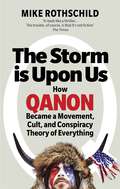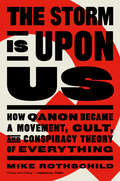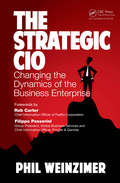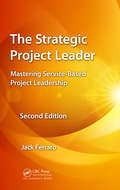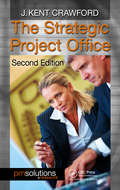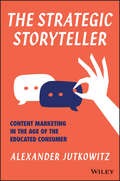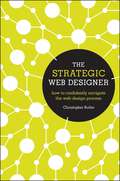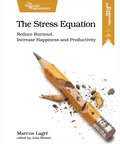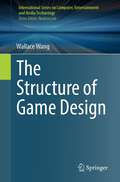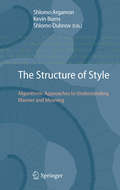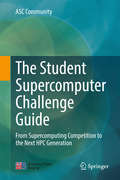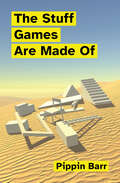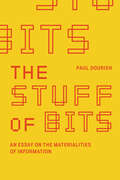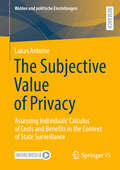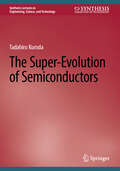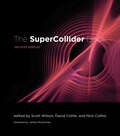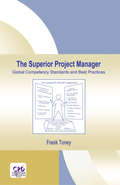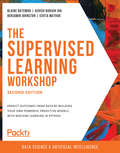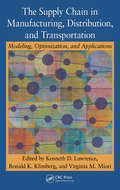- Table View
- List View
The Storm Is Upon Us: How QAnon Became a Movement, Cult, and Conspiracy Theory of Everything
by Mike Rothschild*****'A chilling overview of a movement that should arguably have no place in any healthy, well-educated society.' - The Telegraph'A compelling book.' - The Guardian'The Storm Is Upon Us is an impressive piece of research and a gripping read. Rothschild's book reads like a thriller, with cliffhangers that leave you eager for the next episode. The trouble, of course, is that it's not fiction.' - The Times'An ideal tour guide for your journey into the depths of the rabbit hole that is QAnon, and even shows you a glimmer of light at the exit.' - Cullen Hoback, director of HBO's Q: Into the StormIn 2017, President Trump made a cryptic remark at a gathering of military officials, describing it as 'the calm before the storm'-then refused to explain himself to puzzled journalists. But on internet message boards, a mysterious poster called 'Q Clearance Patriot' began an elaboration all of their own.Q's wild yarn hinted at a vast conspiracy that satisfied the deepest desires of MAGA-America. None of Q's predictions came to pass. But did that stop people from clinging to every word, expanding Q's mythology, and promoting it ever more widely? No.Conspiracy culture expert Mike Rothschild is uniquely equipped to explain QAnon, from the cults that first fed into it, to its embrace by Trump and the right-wing media. With families torn apart and with the Capitol under attack, he argues that mocking the madness of QAnon will get us nowhere. Instead, he argues that QAnon tells us everything we need to know about global fear after Trump-and that we need to understand it now, because it's not going away.
The Storm is Upon Us: How QAnon Became a Movement, Cult, and Conspiracy Theory of Everything
by Mike Rothschild"An ideal tour guide for your journey into the depths of the rabbit hole that is QAnon. It even shows you a glimmer of light at the exit." —Cullen Hoback, director of HBO's Q: Into the Storm Its messaging can seem cryptic, even nonsensical, yet for tens of thousands of people, it explains everything: What is QAnon, where did it come from, and is the Capitol insurgency a sign of where it&’s going next? On October 5th, 2017, President Trump made a cryptic remark in the State Dining Room at a gathering of military officials. He said it felt like &“the calm before the storm&”—then refused to elaborate as puzzled journalists asked him to explain. But on the infamous message boards of 4chan, a mysterious poster going by &“Q Clearance Patriot,&” who claimed to be in &“military intelligence,&” began the elaboration on their own. In the days that followed, Q&’s wild yarn explaining Trump's remarks began to rival the sinister intricacies of a Tom Clancy novel, while satisfying the deepest desires of MAGA-America. But did any of what Q predicted come to pass? No. Did that stop people from clinging to every word they were reading, expanding its mythology, and promoting it wider and wider? No. Why not? Who were these rapt listeners? How do they reconcile their worldview with the America they see around them? Why do their numbers keep growing? Mike Rothschild, a journalist specializing in conspiracy theories, has been collecting their stories for years, and through interviews with QAnon converts, apostates, and victims, as well as psychologists, sociologists, and academics, he is uniquely equipped to explain the movement and its followers. In The Storm Is Upon Us, he takes readers from the background conspiracies and cults that fed the Q phenomenon, to its embrace by right-wing media and Donald Trump, through the rending of families as loved ones became addicted to Q&’s increasingly violent rhetoric, to the storming of the Capitol, and on. And as the phenomenon shows no sign of calming despite Trump&’s loss of the presidency—with everyone from Baby Boomers to Millennial moms proving susceptible to its messaging—and politicians starting to openly espouse its ideology, Rothschild makes a compelling case that mocking the seeming madness of QAnon will get us nowhere. Rather, his impassioned reportage makes clear it's time to figure out what QAnon really is — because QAnon and its relentlessly dark theory of everything isn&’t done yet.
The Strategic CIO: Changing the Dynamics of the Business Enterprise
by Philip WeinzimerRecognized as One of the Best Business Books for 2014 by CIO Magazine Based on interviews with more than 150 CIOs, IT/business executives, and academic thought leaders, The Strategic CIO: Changing the Dynamics of the Business Enterprise provides insight, success stories, and a step-by-step methodology to transform your IT organization into a strategic asset that drives customer value, increases revenues, and enhances shareholder wealth. The book details how strategic CIOs from FedEx, Procter & Gamble, McKesson, and other leading companies transformed their organizations. It illustrates the methods these CIOS used to become strategic partners that collaborate effectively within their organizations to leverage information and technology for a competitive advantage.The text will help you assess the key competencies and skills required by IT personnel to partner with your business teams to create new and enhanced products and services that create customer value, increase margin, and enhance shareholder wealth.The book includes powerful methodologies, time-saving templates, proven best practices, and helpful assessments. It also details a four-phase methodology, along with the associated activities and tools, to help your IT organization successfully transform into a strategic IT organization.Gain insight into the four domain competencies and twelve associated skills required to build effective strategic IT organizations. Build your roadmap to success using the transformation methodology described in the text and you will be on your way to making your organization a strategic IT organization. Read Philip Weinzimer’s recent article that appeared on CIO.com.
The Strategic Project Leader: Mastering Service-Based Project Leadership, Second Edition
by Jack FerraroThis second edition of the Strategic Project Leader prepares project managers to develop leadership competencies that translate into increased confidence to lead in a demanding environment. Like the first edition, this book motivates readers to take ownership of their leadership agenda and become disciplined in the processes of building a framework of leadership skills. This in turn will move readers beyond the basics of project management to true project leadership, positioning themselves for greater leadership opportunities.
The Strategic Project Office (PM Solutions Research)
by J. Kent CrawfordThe second edition of this award-winning reference provides step-by-step instructions for establishing and maturing a project management office (PMO). Concise and easy to read, The Strategic Project Office, Second Edition covers the four primary areas of knowledge and practice regarding the PMO: governance and portfolio management, resource optimization, organizational change, and performance measurement.Winner of the 2001 David I. Cleland Project Management Literature Award from the Project Management Institute, the first edition introduced the concept of PMO as a strategic resource. This second edition adds reporting on cutting-edge research on the status and roles of today’s PMO, highlights best practices, and includes case studies of award-winning PMOs. It explores the various aspects of planning and implementing the strategic PMO and provides readers with an assessment model for measuring PMO practice maturity.New in the Second Edition: New and updated information on the use of collaborative and social media tools in project management New chapters on Project Portfolio Management and aligning projects and strategy New information on using the Strategic Project Office as a strategy management center Updated content that reflects the latest version of the PMBOK® Guide Downloadable resources with time-saving templates and forms The first edition has been the foundation for much of my thinking about initiative management, and the second edition takes thought leadership to a new level. Crawford leverages years of experience to further improve an already excellent resource. The first edition of The Strategic Project Office sits on the top shelf of my bookcase. I’m sure that the second edition will have a similar pride of place … when I haven’t loaned it out to members of my team as homework.—Paul Ritchie, PMP, Director, Global PMO, Mead Johnson Nutrition, Inc.Praise for the Award-Winning First Edition:… provides a primer that is first-of-a-kind and best-of-class. Read it. Learn its lessons. Apply them. Improve your organization, your projects, and your global competitiveness.—PM Network, Books in Focus
The Strategic Storyteller: Content Marketing in the Age of the Educated Consumer
by Alexander JutkowitzThe world needs more storytellers. Storytelling is an inherently innovative activity. When organizations find their best stories and tell them to the world, they’re not only building a reputation, they're flexing the same muscles that allow them to pivot quickly around crisis or opportunity, and solve problems more creatively. For individuals, crafting stories is the primary way we can make sense of the world and our place in it. The Strategic Storyteller is a comprehensive, practical guide to transformative storytelling. In its pages you will learn how to: Tap into your and your organization's unique sources of wonder, wisdom, and delight Boost individual and collective creativity Understand the storytelling strategies behind some of the world’s most powerful brands Unlock the secrets of the great strategic storytellers of the past Build a place where your stories can live online Distribute stories so they have staying power and reach in the digital age Convene audiences by going beyond demographic stereotypes and tapping into enduring human needs Understand how unshakable reputations are built out of stories that accumulate over time Sooner or later all of us will be asked to tell stories in the course of our professional lives. We will be asked to make a case for ourselves, our work, our companies, and our future. The Strategic Storyteller tells you how.
The Strategic Web Designer
by Christopher ButlerExpand your strategic capabilities and technological understanding! Your clients are looking for an expert--someone who understands rapidly changing technology and can provide strategic insight into their web projects from inception and development to launch and beyond. Are you that person? Today, designers are expected to provide a level of web expertise that extends far beyond just good design. The Strategic Web Designer provides you with a foundation that will allow you to keep your bearings in an industry filled with constant technological change. You'll learn to: Plan web projects Organize information in ways that make sense Understand analytics Optimize content for search engines and mobile technology And more! More than a book about building websites, The Strategic Web Designer is your guide to thinking about the web in a strategic and comprehensive manner. Be more than just a web designer--take charge of your web projects and make yourself invaluable to clients.
The Strategic Web Designer
by Christopher ButlerExpand your strategic capabilities and technological understanding! Your clients are looking for an expert--someone who understands rapidly changing technology and can provide strategic insight into their web projects from inception and development to launch and beyond. Are you that person? Today, designers are expected to provide a level of web expertise that extends far beyond just good design. The Strategic Web Designer provides you with a foundation that will allow you to keep your bearings in an industry filled with constant technological change. You'll learn to: Plan web projects Organize information in ways that make sense Understand analytics Optimize content for search engines and mobile technology And more! More than a book about building websites, The Strategic Web Designer is your guide to thinking about the web in a strategic and comprehensive manner. Be more than just a web designer--take charge of your web projects and make yourself invaluable to clients.
The Strategic Web Designer: How to Confidently Navigate the Web Design Process
by Christopher ButlerExpand your strategic capabilities and technological understanding!Your clients are looking for an expert--someone who understands rapidly changing technology and can provide strategic insight into their web projects from inception and development to launch and beyond. Are you that person?Today, designers are expected to provide a level of web expertise that extends far beyond just good design. The Strategic Web Designer provides you with a foundation that will allow you to keep your bearings in an industry filled with constant technological change. You'll learn to:Plan web projectsOrganize information in ways that make senseUnderstand analyticsOptimize content for search engines and mobile technologyAnd more! More than a book about building websites, The Strategic Web Designer is your guide to thinking about the web in a strategic and comprehensive manner. Be more than just a web designer--take charge of your web projects and make yourself invaluable to clients.
The Stress Equation
by Marcus LagreWorkplace stress is not the weakness of individuals; it's caused by systemic problems. Armed with the insights in this book, you can identify, analyze, and systematically reduce the factors that lead to poor health, low productivity, and personal burnout. This book gives you a framework for understanding stress, and a vocabulary to make it easier to discuss it among colleagues. Stress can be fixed; find out how. The interviewer asks, "How well do you cope with stress?" Your response should be, "Let's fix your environment so we don't have to." Work-related stress is one of the leading causes of mental illness among white-collar workers. It hurts companies, projects, and (most importantly) people! Stress is a burden that's created when teams stop working well. The Stress Equation is a model and a tool to help talk about stress as a systemic issue. By exploring how pressure, complexity, and security interact in software teams, we move focus away from the individual, so that we can talk about stress from a team and organizational perspective. By exploring external factors, we discuss how to solve problems rather than cope with the consequences. Whether you're an individual feeling stressed or a manager who can help, you'll learn the causes of, fixes for, and how to talk about stress. We regulate pressure by how we decide how much work we have to do and when it needs to be finished. Complexity is decided by how we handle our product and organization design. Our security is less about our pay and benefits, and more about the support and trust we feel.Stress should not be a given. Instead, it's a symptom of a diseased organization. With this book, you can begin the healing process.What You Need:No special requirements.
The Structure of Game Design (International Series on Computer, Entertainment and Media Technology)
by Wallace WangThe Structure of Game Design is designed to help aspiring and existing game designers turn their ideas into working games. Creating a game involves understanding the core foundational elements of all types of games from paper-based games to the latest video games. By understanding how these core principles work in all types of games, you can apply these same principles to design your own game. Games are about goals, structure, play and fun. While everyone will always have their own idea of what might be “fun”, any game designer can maximize player enjoyment through meaningful choices that offer various risks and rewards. Such challenges, combined with rules and limitations, force players to overcome obstacles and problems using a variety of skills including dexterity, puzzle solving, intelligence, and strategy. Essentially games allow players to venture forth into new worlds and overcome problems in a safe but exciting environment that allows them to triumph in the end. Just as playing games have proven popular around the world to all ages, genders, and cultures, so has game designing proven equally popular. Games can challenge players to make the best move, solve puzzles, engage in combat, manage resources, and tell stories. By understanding how randomness, psychology, and balance can change the way games play, readers can decide what game elements are best for their own game creation. Whether your goal is to make money, learn something new, make a social statement, improve on an existing game idea, or challenge your artistic, programming, or design skills, game design can be just as much fun as game playing. By knowing the parts of a game, how they work, how they interact, and why they’re fun, you can use your knowledge to turn any idea into a game that others can play and enjoy.
The Structure of Style
by Shlomo Dubnov Kevin Burns Shlomo ArgamonStyle is a fundamental and ubiquitous aspect of the human experience: Everyone instantly and constantly assesses people and things according to their individual styles, academics establish careers by researching musical, artistic, or architectural styles, and entire industries maintain themselves by continuously creating and marketing new styles. Yet what exactly style is and how it works are elusive: We certainly know it when we see it, but there is no shared and clear understanding of the diverse phenomena that we call style. The Structure of Style explores this issue from a computational viewpoint, in terms of how information is represented, organized, and transformed in the production and perception of different styles. New computational techniques are now making it possible to model the role of style in the creation of and response to human artifacts--and therefore to develop software systems that directly make use of style in useful ways. Argamon, Burns, and Dubnov organize the research they have collected in this book according to the three roles that computation can play in stylistics. The first section of the book, Production, provides conceptual foundations by describing computer systems that create artifacts--musical pieces, texts, artworks--in different styles. The second section, Perception, explains methods for analyzing different styles and gleaning useful information, viewing style as a form of communication. The final section, Interaction, deals with reciprocal interaction between style producers and perceivers, in areas such as interactive media, improvised musical accompaniment, and game playing. The Structure of Style is written for researchers and practitioners in areas including information retrieval, computer art and music, digital humanities, computational linguistics, and artificial intelligence, who can all benefit from this comprehensive overview and in-depth description of current research in this active interdisciplinary field.
The Student Supercomputer Challenge Guide
by Asc CommunityThis guide provides a comprehensive overview of High Performance Computing (HPC) to equip students with a full skill set including cluster setup, network selection, and a background of supercomputing competitions. It covers the system, architecture, evaluating approaches, and other practical supercomputing techniques. As the world’s largest supercomputing hackathon, the ASC Student Supercomputer Challenge has attracted a growing number of new talent to supercomputing and has greatly promoted communications in the global HPC community. Enclosed in this book, readers will also find how to analyze and optimize supercomputing systems and applications in real science and engineering cases.
The Student's Introduction to Mathematica®
by Bruce F. Torrence Eve A. TorrenceThe unique feature of this compact student's introduction is that it presents concepts in an order that closely follows a standard mathematics curriculum, rather than structure the book along features of the software. As a result, the book provides a brief introduction to those aspects of the Mathematica software program most useful to students. The second edition of this well loved book is completely rewritten for Mathematica 6 including coverage of the new dynamic interface elements, several hundred exercises and a new chapter on programming. This book can be used in a variety of courses, from precalculus to linear algebra. Used as a supplementary text it will aid in bridging the gap between the mathematics in the course and Mathematica. In addition to its course use, this book will serve as an excellent tutorial for those wishing to learn Mathematica and brush up on their mathematics at the same time.
The Stuff Games Are Made Of (Playful Thinking)
by Pippin BarrA deep dive into practical game design through playful philosophy and philosophical play.What are video games made of? And what can that tell us about what they mean? In The Stuff Games Are Made Of, experimental game maker Pippin Barr explores the materials of video game design. Taking the reader on a deep dive into eight case studies of his own games, Barr illuminates the complex nature of video games and video game design, and the possibilities both offer for exploring ideas big and small.Through a variety of engaging and approachable examples, Barr shows how every single aspect of a game—whether it is code, graphics, interface, or even time itself—can be designed with and related to the player experience. Barr&’s experimental approach, with its emphasis on highly specific elements of games, will leave readers armed with intriguing design philosophy, conceptual rigor, and diverse insights into the inner life of video games. Upon finishing this book, readers will be ready to think deeply about the nature of games, to dive into expressive and experimental game design themselves, or simply to play with a new and expanded mindset.
The Stuff of Bits: An Essay on the Materialities of Information (The\mit Press Ser.)
by Paul DourishAn argument that the material arrangements of information—how it is represented and interpreted—matter significantly for our experience of information and information systems.Virtual entities that populate our digital experience, like e-books, virtual worlds, and online stores, are backed by the large-scale physical infrastructures of server farms, fiber optic cables, power plants, and microwave links. But another domain of material constraints also shapes digital living: the digital representations sketched on whiteboards, encoded into software, stored in databases, loaded into computer memory, and transmitted on networks. These digital representations encode aspects of our everyday world and make them available for digital processing. The limits and capacities of those representations carry significant consequences for digital society. In The Stuff of Bits, Paul Dourish examines the specific materialities that certain digital objects exhibit. He presents four case studies: emulation, the creation of a “virtual” computer inside another; digital spreadsheets and their role in organizational practice; relational databases and the issue of “the databaseable”; and the evolution of digital networking and the representational entailments of network protocols. These case studies demonstrate how a materialist account can offer an entry point to broader concerns—questions of power, policy, and polity in the realm of the digital.
The Subjective Value of Privacy: Assessing Individuals’ Calculus of Costs and Benefits in the Context of State Surveillance (Wahlen und politische Einstellungen)
by Lukas AntoineThis book critically examines the subjective value of privacy in the context of state surveillance, exploring how individuals assess costs and benefits of surveillance. It delves into the complex relationship between attitudes towards privacy, security, and state surveillance and challenges the conventional privacy versus security trade-off through three empirical studies. The first study finds that security justifications for surveillance indeed influence public support for surveillance, particularly in liberal democracies. The second study reveals how financial costs and personal convenience influence support for surveillance. The third study suggests that privacy attitudes may be a stable personality trait, influencing decisions across various contexts. By employing cross-comparative analysis and experimental designs, this book enhances our understanding of privacy's subjective value, refines theoretical frameworks, and offers insights into individual decision-making about privacy. By highlighting the dynamic nature of privacy preferences, this work reveals limitations of simplistic theoretical models and sets the stage for future research in the privacy-security nexus.
The Successful Software Manager: The definitive guide to growing from developer to manager
by Herman FungA developer's guide to successfully managing teams, customers, and software projects Key Features A complete guide to managing developer teams, software projects, customers, and users Transition successfully from a technical role to management Develop crucial skills to enhance your performance and advance your career Book Description The Successful Software Manager is a comprehensive and practical guide to managing software developers, software customers, and the process of deciding what software needs to be built. It explains in detail how to develop a management mindset, lead a high-performing developer team, and meet all the expectations of a good manager. The book will help you whether you've chosen to pursue a career in management or have been asked to "act up" as a manager. Whether you're a Development Manager, Product Manager, Team Leader, Solution Architect, or IT Director, this is your indispensable guide to all aspects of running your team and working within an organization and dealing with colleagues, customers, potential customers, and technologists, to ensure you build the product your organization needs. This book is the must-have authoritative guide to managing projects, managing people, and preparing yourself to be an effective manager. The intuitive real-life examples will act as a desk companion for any day-to-day challenge, and beyond that, Herman will show you how to prepare for the next stages and how to achieve career success. What you will learn Decide if moving to management is right for you Develop the skills required for management Lead and manage successful software development projects Understand the various roles in a technical team and how to manage them Motivate and mentor your team Deliver successful training and presentations Lead the design process with storyboards and personas, and validate your solution Who this book is for Development Managers, Product Managers, Team Leaders, Solution Architects, or IT Directors who want to effectively manage colleagues, customers, potential customers, and technologists.
The Successful Virtual Classroom: How to Design and Facilitate Interactive and Engaging Live Online Learning
by Darlene Christopher Karen HYDERDesigners and facilitators must adapt their programs and delivery styles to be effective in the new medium that is virtual training.Virtual training gives learning professionals unprecedented flexibility, making it possible to reach participants globally and unite physically dispersed teams. This book goes beyond introducing the technology, to offer trainers proven techniques tailored specifically to engage live online audiences. In Successful Virtual Classroom, you will learn how to: Make the most of virtual classroom features such as content and screen sharing, annotation tools, polls, and breakout rooms Weave chat responses into the discussion Compensate for the absence of body language Monitor feedback Engage individuals with different learning styles Encourage audience contribution Meet the unique needs of global participants Packed with easy-to-use tools, checklists, and worksheets--as well as case studies from?Oracle,?UPS, and more--the book introduces the PREP model for planning, rehearsing, executing, and then conducting a postmortem following the training event.Featuring icebreakers and interactive exercises designed for an online environment, Successful Virtual Classroom helps you create programs that truly drive learner engagement.
The Super-Evolution of Semiconductors (Synthesis Lectures on Engineering, Science, and Technology)
by Tadahiro KurodaThis book presents the author’s view of how the global semiconductor industry will evolve, based on recent megatrends not only in the industry but also in society, including the rapid proliferation of AI, the global semiconductor shortage, the rising importance of semiconductors in the value chain, and the movement to democratize semiconductors. It describes and explains major transformations taking place in the industry as a result, which necessitate significant changes not only to its technology but also its economic model and industrial structure. Finally, the book elaborates on the author’s theory of super-evolution of semiconductors that will lead to the success of the industry in the emerging knowledge-based digital society.
The SuperCollider Book, second edition
by Scott Wilson Nick Collins David CottleA comprehensive update of the essential reference to SuperCollider, with new material on machine learning, musical notation and score making, SC Tweets, alternative editors, parasite languages, non-standard synthesis, and the cross-platform GUI library.SuperCollider is one of the most important domain-specific audio programming languages, with wide-ranging applications across installations, real-time interaction, electroacoustic pieces, generative music, and audiovisuals. Now in a comprehensively updated new edition, The SuperCollider Book remains the essential reference for beginners and advanced users alike, offering students and professionals a user-friendly guide to the language’s design, syntax, and use. Coverage encompasses the basics as well as explorations of advanced and cutting-edge topics including microsound, sonification, spatialization, non-standard synthesis, and machine learning. Second edition highlights: • New chapters on musical notation and score making, machine learning, SC Tweets, alternative editors, parasite languages, non-standard synthesis, SuperCollider on small computers, and the cross-platform GUI library• New tutorial on installing, setting up, and running the SuperCollider IDE• Technical documentation of implementation and information on writing your own unit generators• Diverse artist statements from international musicians• Accompanying code examples and extension libraries
The Superior Project Manager: Global Competency Standards and Best Practices (PM Solutions Research)
by Frank ToneyDescribes global best practices, competencies, and standards of superior project organizations based on research conducted by the Top 500 Project Management Forum. It emphasizes the selection process, performance evaluation, and personnel development to provide the key elements for adjusting and adapting to flexible conditions. The text also highli
The Superior Project Organization: Global Competency Standards and Best Practices (PM Solutions Research)
by Frank ToneyThis text describes global best practices, competencies, and standards of superior project organizations based on research conducted by the Top 500 Project Management Forum. It details the results of seven years of benchmarking and the bottom line value of project organizations in large functional enterprises. The text also highlights enhancements in professional image, job performance, and personal earnings.
The Supervised Learning Workshop: A New, Interactive Approach to Understanding Supervised Learning Algorithms, 2nd Edition
by Benjamin Johnston Ishita Mathur Blaine Bateman Ashish Ranjan JhaCut through the noise and get real results with a step-by-step approach to understanding supervised learning algorithms Key Features Ideal for those getting started with machine learning for the first time A step-by-step machine learning tutorial with exercises and activities that help build key skills Structured to let you progress at your own pace, on your own terms Use your physical print copy to redeem free access to the online interactive edition Book Description You already know you want to understand supervised learning, and a smarter way to do that is to learn by doing. The Supervised Learning Workshop focuses on building up your practical skills so that you can deploy and build solutions that leverage key supervised learning algorithms. You'll learn from real examples that lead to real results. Throughout The Supervised Learning Workshop, you'll take an engaging step-by-step approach to understand supervised learning. You won't have to sit through any unnecessary theory. If you're short on time you can jump into a single exercise each day or spend an entire weekend learning how to predict future values with auto regressors. It's your choice. Learning on your terms, you'll build up and reinforce key skills in a way that feels rewarding. Every physical print copy of The Supervised Learning Workshop unlocks access to the interactive edition. With videos detailing all exercises and activities, you'll always have a guided solution. You can also benchmark yourself against assessments, track progress, and receive content updates. You'll even earn a secure credential that you can share and verify online upon completion. It's a premium learning experience that's included with your printed copy. To redeem, follow the instructions located at the start of your book. Fast-paced and direct, The Supervised Learning Workshop is the ideal companion for those with some Python background who are getting started with machine learning. You'll learn how to apply key algorithms like a data scientist, learning along the way. This process means that you'll find that your new skills stick, embedded as best practice. A solid foundation for the years ahead. What you will learn Get to grips with the fundamental of supervised learning algorithms Discover how to use Python libraries for supervised learning Learn how to load a dataset in pandas for testing Use different types of plots to visually represent the data Distinguish between regression and classification problems Learn how to perform classification using K-NN and decision trees Who this book is for Our goal at Packt is to help you be successful, in whatever it is you choose to do. The Supervised Learning Workshop is ideal for those with a Python background, who are just starting out with machine learning. Pick up a Workshop today, and let Packt help you develop skills that stick with you for life.
The Supply Chain in Manufacturing, Distribution, and Transportation: Modeling, Optimization, and Applications
by Kenneth D. Lawrence Ronald K. Klimberg Virginia M. MioriReporting on cutting-edge research in production, distribution, and transportation, The Supply Chain in Manufacturing, Distribution, and Transportation: Modeling, Optimization, and Applications provides the understanding needed to tackle key problems within the supply chain. Viewing the supply chain as an integrated process with regard to tactical
